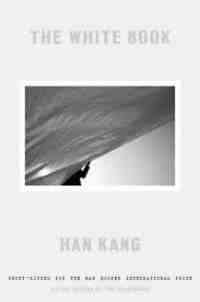The White Book by Han Kang
 Wednesday, February 20, 2019 at 9:10AM
Wednesday, February 20, 2019 at 9:10AM 
First published in South Korea in 2016; published in translation in Great Britain in 2017; published by Crown/Hogarth on February 19, 2019
The unnamed narrator of The White Book decides to write about white things, expecting to be transformed by the experience. Most chapters of The White Book revolve around a white item on the list. The white door on an apartment she rented. Rice cakes before they are steamed. A handkerchief falling from a balcony rail. The Korean phrase “laughing whitely,” meaning cheerless or forced laughter. Frost that causes leaves to fall from trees, “incrementally lightening their burden.” The chapters are short, sometimes only a single paragraph. A couple of sections are written in verse.
The narrator associates some of the white objects with “oppressive fragments of memory” that “constantly drift to the surface” as she walks the streets of a bleak and unfamiliar city (presumably Warsaw) that is cloaked in white fog. She has seen footage taken by American aircraft showing how the rubble of the bombed city looked like white snow.
Sugar cubes remind the narrator of her of her childhood. From her mother, she learned of the white newborn gown that was used during the premature birth of her mother’s first baby. The baby died after two hours and the birthing gown became a white burial shroud. She imagines her mother’s white breast milk that the baby will never consume. Had that death not occurred, the narrator would not have been born. For that reason and others, the narrator is living a haunted life.
To some extent, The White Book is a meditation on color and light: the way objects in the dark may appear as a hazy white glow; the way the moon can be bright white or pale blue or mottled; the way a stage becomes an island of white light surrounded by a dark sea. It is also a meditation on culture. The narrator spreads a white skirt on her mother’s grave and burns it, white smoke ascending so that her mother’s spirit will be able to wear it. She performs the ritual while wondering whether anyone believes in its literal truth, but appreciates the silent solemnity of the act.
Some topics suggest the transitory and impermanent nature of all things: pristine snow that darkens with a city’s grime or mutely disappears; waves that become “dazzlingly white” before shattering in “a spray of white:” a white dog that sickens and dies; sturdy white bones that shatter and turn to sand; the ash of a cremated body; the white hair of lovers who will soon part from each other forever. Small white pills ease pain, impeding the body’s progress toward the white light that is said to be death. Yet sugar cubes remind her of her childhood, memories that “remain inviolate to the ravages of time,” evidence that time and suffering do not bring everything to ruin.
We come to understand that the narrator has suffered losses, including a lost love that makes her fearful of loving again, and that she was once on the brink of suicide, but now holds those thoughts in reserve. She is surrounded by dreariness but also delicacy — a white butterfly, white reeds growing in a marsh — and that balance between light and dark is one that could change at any moment, in either direction. Through abstract associations of light and whiteness, The White Book portrays a woman who has lived on the edge between life and death, but who is slowly reconstructing herself, as the city to which she has traveled is still reconstructing itself after the bombings that failed to destroy it completely.
Fragmented storytelling risks a loss of the narrative cohesion upon which readers depend to help them find a story’s meaning. Han Kang wields the form with great skill, allowing meaning to coalesce as the fragments accumulate. If the story is sometimes depressing, it is ultimately uplifting, and the prose (for which the translator, Deborah Smith, presumably deserves some credit) is always exquisite.
RECOMMENDED
Reader Comments